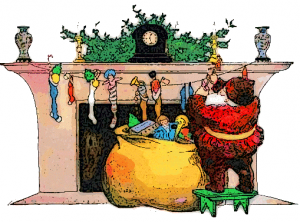
- “We didn’t wait for invites. WE planned a party each year (so we could set our child up for a successful celebration with friends). We kept it short, took pictures (document success), included activities that interested our child, and pre-taught everything!”
- “Driving around looking at lights is a favorite! We did the Lantern Tour (historical re-enactors) at Fort Missoula last year. Not all buildings were accessible, but most were and it was well worth it.”
- “Consider foregoing the Christmas candles. Between the potential for burns, ‘art’ drawn on your tabletop in warm, gooey wax, and out-and-out fire… Just forego the Christmas candles.”
- “I shopped and mailed alone. Only exception was to take each child to buy a gift for their sibling. We made that a ‘date.’”
- “Repetitive, assembly-line based activities are calming for kids, especially for those with autism and/or ADHD. Choose some holiday projects that are based on this concept. For example, peanutbutter kiss cookies have lots of repeatable, calming steps: unwrapping the kisses, rolling the dough into little balls, pressing a glass into a bowl of sugar and then onto the ball of dough to flatten it a bit, and finally, pushing a kiss down into each warm, fragrant cookie. The repetition, predictability, and promise of sweet reward make for a successful and calming project.” (Click here for Betty Crocker’s Classic Peanut Butter Blossom recipe.)
- “In the early years we tried to educate family that our child would need down time, might not greet them in a way that made them feel as loved as they were, might not react to a gift in an expected way (or even acknowledge it)… set appropriate expectations.”
- “Don’t solely look to one specific day (like Christmas) to feel like a celebration. Give yourself time (the holiday season) to find joyful moments.”
- “Be willing to let some long-standing traditions go. Historically, our festivities have always included a present-opening frenzy on Christmas eve. But the noise and chaos are too much for our son. Now we put our son’s presents in his bedroom on Christmas eve. He might open one, he might not. He might wait until mid-January, then delightedly tear open every gift. The point being, we quit worrying about maintaining traditions that didn’t work for our family. And we quit worrying about disappointing relatives who want to watch him open his presents. We let him be himself, enjoying his Christmas his way.”
- “Prepare yourself for gifts that may not be quite right, or even usable. Remember that the giver’s intention was probably good!”
- “If your child is unsettled by changes in the home, make sure there is calm, Christmas-free space. If your other children are upset by minimal decorations, let them go wild decorating their own rooms.”
- “If you can’t return or exchange (an inappropriate gift), pass it on to someone who can use it. Make sure a kid with a disability will be receiving a majority of toys he is able to handle. Look at gift guides for PWD (Persons With Disabilities). New Mobility covers cool and innovative stuff sometimes and I imagine there are autism gift guides out there.”
- “Don’t allow one parent to shoulder all of the additional responsibilities of your child with special needs. Take turns being the one who leaves early with him. Make sure both parents get to enjoy some outings with the other children in the family. Resentment or score-keeping will sour Christmas for the whole family.”
- “If your child is receptive, give him a job, like hanging coats, filling water glasses before dinner, or bringing a cookie tray around to guests. This might channel his energy and focus his attention.”
• “The holidays are a great time to gently raise awareness among family members we see less often. Take kids aside and answer their questions, since they may not get much (or any) info at home.”
